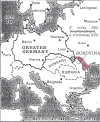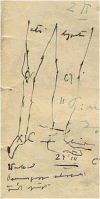Born in Czernowitz in 1903, Arthur Kessler (Figure 1) only became a Romanian citizen after World War I. With a doctorate in medicine from Vienna, Kessler was recruited into the Romanian army. He was transferred to reserve duties only in 1930 and allowed to practice privately. With the Nazi invasion of Romania, his activities were progressively curtailed, and in 1942 Kessler was deported to the province of Transnistria, a narrow strip of land situated between Moldova in the west and the Ukraine in the east, between the rivers Bug and Dniester (Figure 2).9
 | Figure 2 Map of Eastern Europe Showing the Location of Transnistria (red). |
Vapniarka and Grass Pea
This region was uncultivated at the time and prone to harsh winters. The passing German forces found large quantities of grass pea horse-fodder left behind by the retreating Soviets. Possibly as a deliberate experiment
10 they suggested feeding grass pea to the prisoners in Vapniarka. The Nazis would not have been unaware of the toxicity of grass pea (
Lathyrus sativus), which is now known to contain a toxic alanine product known as oxalyldiaminopropionic acid (ODAP). The leadership of Vapniarka was Romanian; hence their willingness to feed their prisoners with bread baked from barley and chopped straw and grass peas boiled in salty water is noteworthy, since without doubt they also knew the grass pea was toxic—grass pea was not included in the diets of the camp personnel at all.
11
Consumed in large quantity and over a prolonged period of time, this “nutrient” had been known to be neurotoxic since antiquity. In Europe, consuming grass pea was forbidden by George, Duke of Württemberg, in 1671, an order re-enforced by his successor, Leopold.12 The consumption of grass pea was also forbidden in France and Algeria in the early nineteenth century. This type of food-poisoning all but disappeared in Europe, except during the civil war in Spain and in the Balkans during WWII, but remained endemic in underdeveloped East African and Far East Asian countries. Nevertheless, historically, famine-afflicted populations relied on the grass pea when it was the only source available for nutrition.
Detection of Grass Pea Poisoning
Kessler ended up in the Vapniarka detention center where he served as a physician to the other incarcerated prisoners. Shortly after his arrival he recorded:
… within months, hundreds of young male inmates of the camp began limping and had begun to use stick-crutches to propel themselves about, in some cases inmates had been rapidly reduced to crawling on their back sides to make their ways through the compound.9,13
Kessler collected the data of hundreds of patients who developed spastic paralysis of the lower limbs while in Vapniarka (Figure 3). He connected their condition with a never-seen and non-existent disease in Europe, not taught in medical schools and not appearing in textbooks. The symptoms involved a gradual paralysis ascending from the lower limbs to the thoracic level of the cortico-spinal tract, later on histologically proven to be a spinal cord degenerative process.11 This upper neuron disease, which would later be called lathyrism, appeared clinically as monoplegia, paraparesis or paraplegia, and incontinence; he meticulously recorded his findings on any available piece of paper.15 Kessler eventually determined that the toxic dosage of grass pea was 300 mg/day over a 3-month period (Figure 4). Kessler wrote: “We are eating poison and we will die of it.”15
 | Figure 3 Dr Kessler’s Drawing of a Paretic Limb, Vapniarka, 1942. |
 | Figure 3 Dr Kessler’s Drawing of the Lathyrus Plant, Vapniarka, 1942. |
Armed with the documented poisoning, the inmates organized a hunger strike.16 When the group confronted one of the brutal commandants of the camp, Kessler wrote that he responded, “what makes you think that we are interested in keeping you alive?”16
Kessler courageously persisted in confronting successive visiting authorities, some interested Romanian physicians, the Governor of the province, and a Ukrainian neurologist familiar with the disease. As a result, the toxic feeding program was replaced with a meagre food supply (two slices of bread a day, dried “fruit,” and artificially sweetened tea).17,18
Additional Medical Challenges in Vapniarka
Despite the success in ending this toxic diet, there was no lack of patients. Starvation and the freezing Ukrainian winter led to aggravated gangrene, necessitating amputations and prostheses. Kessler also had to treat patients severely debilitated by tuberculosis, the typhus exanthematicus that flourished in the summer, despair-induced depression, and those who suffered the irreversible effects of the grass pea food-poisoning. A crutch support was improvised by the inventive physician, bandages for skin ulcerations and gangrene (angio-lathyrism) were manufactured, and various nappy supports were supplied to incontinent patients. Vascular occlusion occurred in adults, and the softened bone deformity (osteo-lathyrism) appeared in developing skeletons.
11,13,15,17–20
Post-Vapniarka
The camp was eventually dismantled, and Kessler was transferred to Olgopol, another camp in the province with even worse conditions. The hunger was more severe, the tuberculosis was more advanced, and typhus was more prevalent. When the war turned against the Nazis, the camp was closed, and the surviving prisoners were returned to Romania proper. There were hundreds of camps in that region, yet today almost nothing remains to testify of their existence, and residents of the region deny that Vapniarka ever existed.
17
Kessler was fortunate to be amongst the surviving half of the 800,000 Jews who lived in pre-war Romania. His documents were hidden and published after liberation.
After the war, Kessler immigrated to Israel and was employed by one of the health maintenance organizations there, practicing allergology. Kessler published numerous articles in local and international medical journals, focusing on lathyrism and pediatric allergology.9 His allergy-related research spanned a number of topics, including bee stings, allergies in infants, sensitivity to medications, bronchial asthma, and allergies to house dust, to mites, and to birds. He warned of the risk of aerosols and dealt with the influence of Israel’s climate on asthma patients, including publications on asthma mortality. Many of his publications remain relevant and continue to be cited today.
Kessler’s Legacy
Kessler’s research was foundational to the discovery of and subsequent research on the residual neural, vascular, and osteopathic symptoms and findings of lathyrism. Lathyrism would continue to be extensively investigated in Ichilov Hospital, Tel Aviv, particularly in the 200 survivors of Vapniarka.
13,15,19,20
Dr Arthur Kessler died in Israel in 2000. However, his research and toxicology tables remain in use to this day. In one renowned case, knowledge of his research led to determining the “mysterious” cause of death of a college student in Alaska.21 Kessler would have been pleased to know that today a new detoxified grass pea that is alanine toxin-free and ODAP-free is being cultivated for use in famine-hit areas.22
